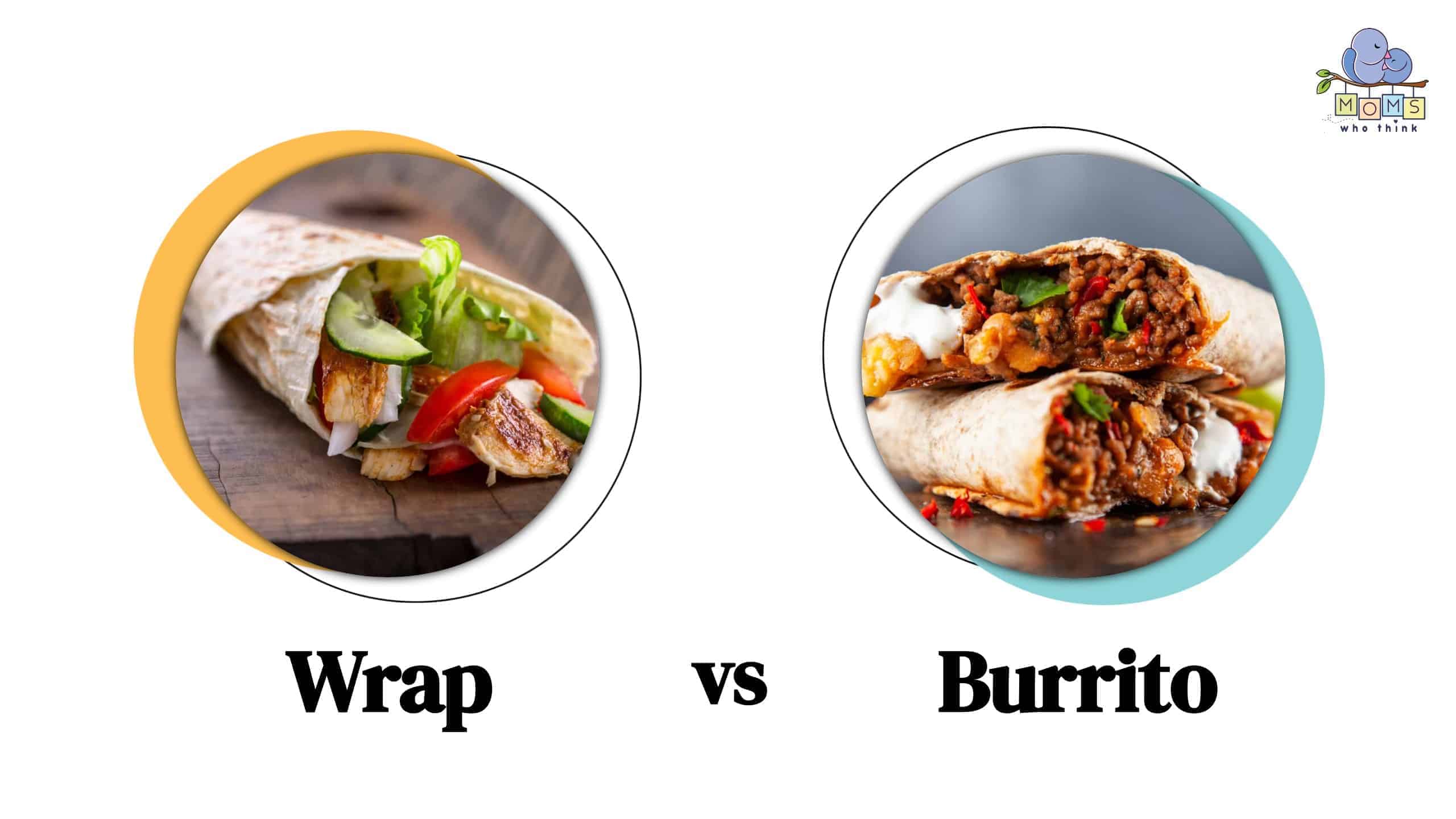Today, we're diving into the wonderful world of wraps and burritos. These handheld delights have become staples in many households — mine included — providing quick, convenient, and satisfying meals. But is a burrito simply a wrap in disguise? Are wraps and burritos the same thing? Can you substitute one for the other? Grab your favorite tortillas because we're getting into the delicious details of each of these handheld dishes.
Are Wraps and Burritos the Same Thing?
At first glance, wraps and burritos may appear similar, but they have some distinct characteristics that set them apart. Most notably, burritos are an iconic Tex-Mex dish with specific components that are signature to the Mexican-American culinary formula. Wraps, on the other hand, are more loosely defined as anything assembled and then folded into a “wrapper” that you can eat.
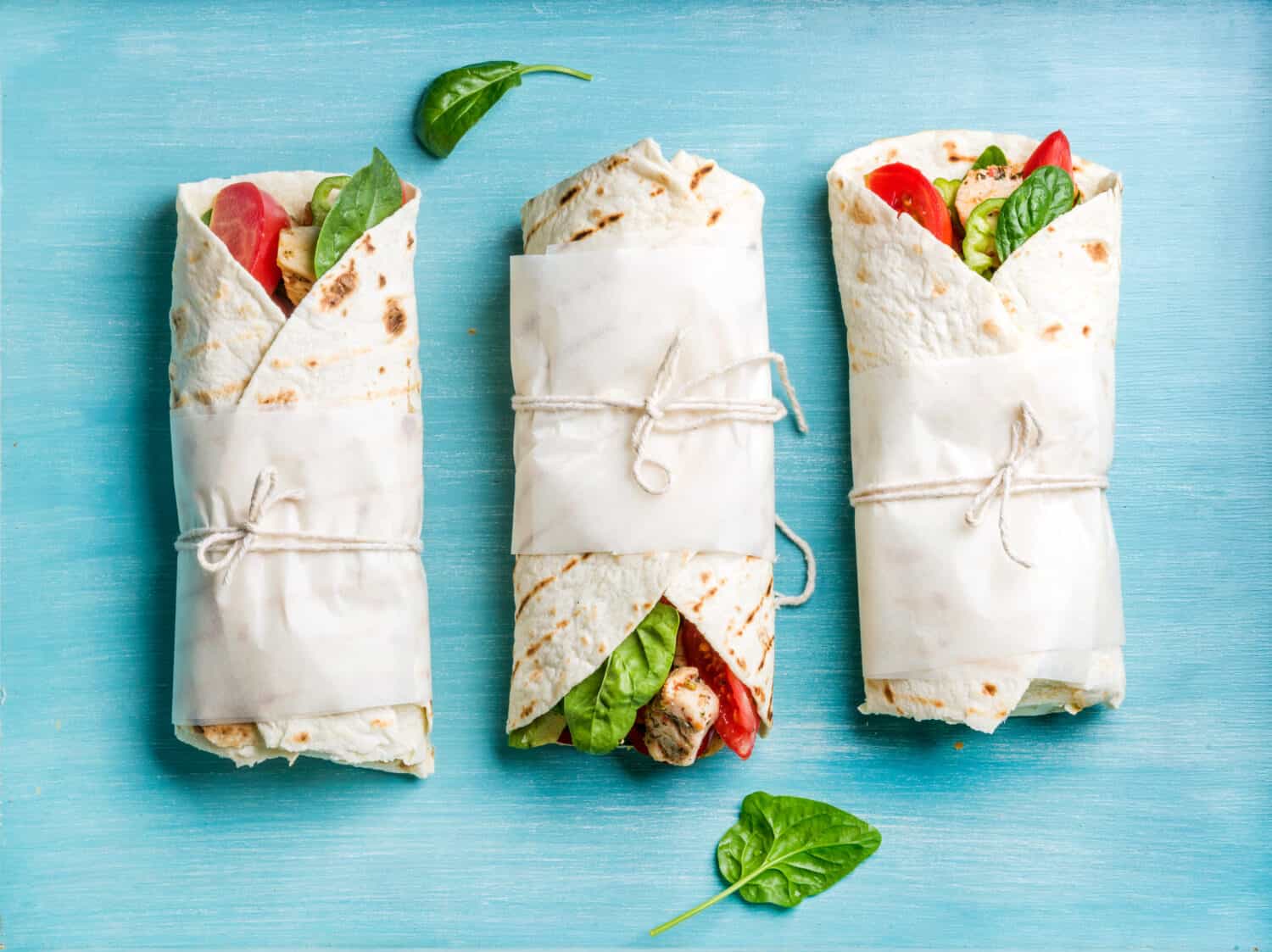
©Foxys Forest Manufacture/Shutterstock.com
Wraps
Easy to conceptualize, wraps are typically made with thin and pliable flatbreads of some sort, including tortillas, lavash, or even lettuce leaves in modern “healthier” circles. Wraps have roots in various global cuisines, including Mexican, Middle Eastern, and Mediterranean culinary cultures. The beauty of wraps lies in their versatility, as they can be filled with an endless array of ingredients, from meats and vegetables to spreads and dressings.
For busy parents, wraps offer one thing that burritos tend to miss: portability. Wraps are typically wholly contained inside the wrapper ingredient. If you wrap your wrap in wax or parchment paper and foil
Burritos
Burritos, on the other hand, are a specific type of wrap that originated in Mexico. They are made using flour tortillas and are traditionally filled with ingredients like beans, rice, meat (such as beef, chicken, or pork), cheese, salsa, and guacamole. Burritos are typically larger and heartier than wraps, packing a flavor punch that satisfies cravings.
Nutritional Differences: Wraps vs. Burritos
When it comes to nutrition, wraps, and burritos can vary depending on the fillings and preparation methods. However, let's take a closer look at the general differences.
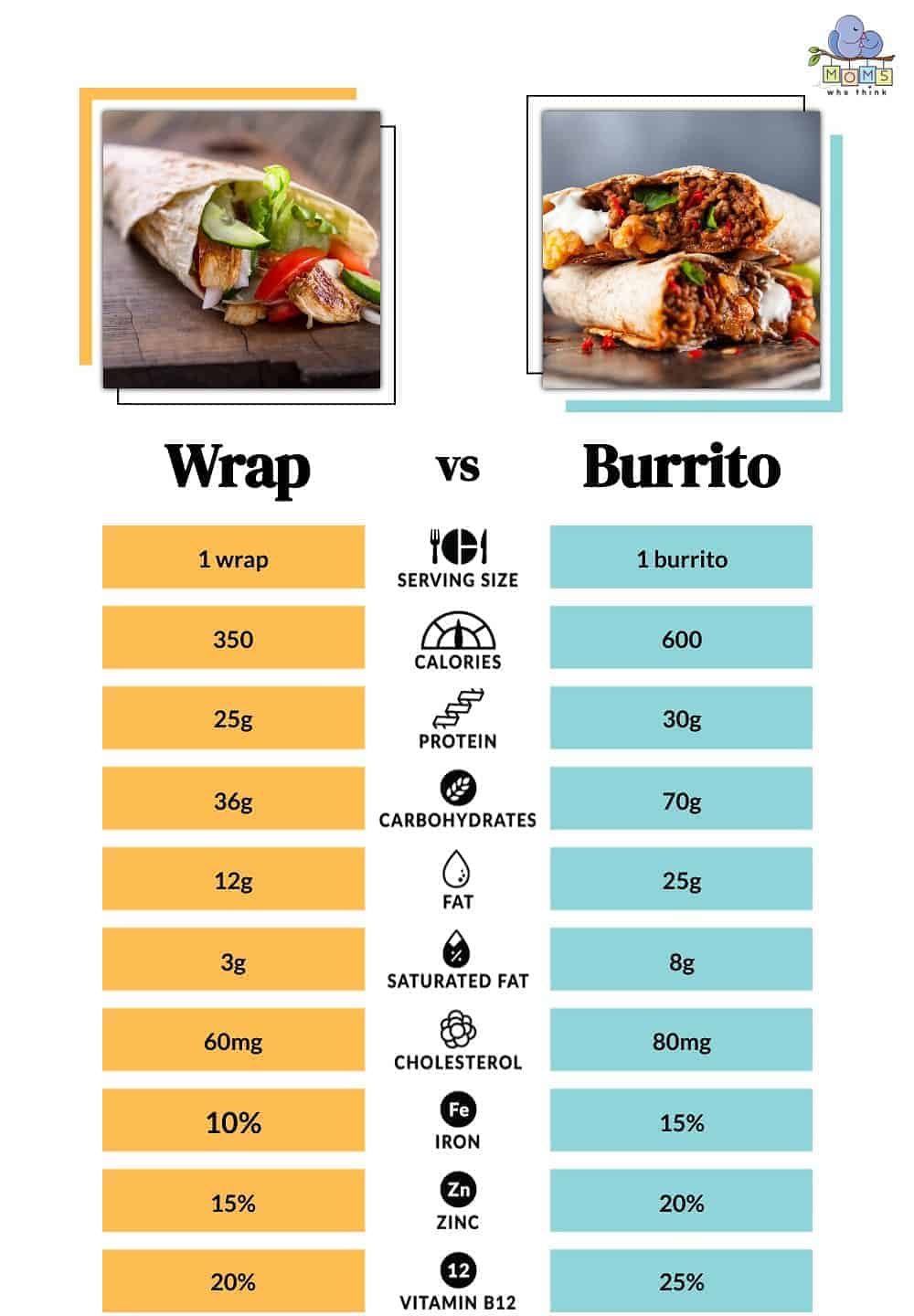
Nutrition and Wraps
Wraps have the advantage of being endlessly customizable and adaptable to various dietary preferences. Without the mandate that they align with a specific regional cuisine, they give you a lot more freedom to tailor them to the preferences and nutritional needs of your family. By selecting nutrient-rich fillings like lean proteins, colorful vegetables, and healthy spreads, wraps can be a fantastic source of vitamins, minerals, and fiber. Opting for whole-grain tortillas further boosts their nutritional value. Now, it's important not to get too heavy-handed with the cheeses or dressings. Moderation with those calorie-dense (but not necessarily nutrient-dense) components is a must.
Nutrition and Burritos
Burritos operate in a much narrower lane when it comes to their ingredients. For this reason, their nutritional values tend to stay relatively high — burritos famously contain both beans and cheeses, not to mention sauces. This means that while they provide a substantial amount of protein, fiber, and carbohydrates, they can also be higher in calories, saturated fat, and sodium compared to wraps. You can solve this issue by choosing leaner meats, incorporating more vegetables, and moderating portion sizes in order to make a healthier burrito.
Can Wraps and Burritos Be Substituted for Each Other?
A burrito is a type of wrap, but not all wraps are burritos. While wraps and burritos share similar construction and ingredient ratios, they have distinct flavors and origins. If you're playing fast and loose with the language, you could call anything a fill-in-the-blank burrito, but without the signature Tex-Mex ingredient combination, you're walking a fine line semantically.
Wraps as a Burrito Alternative
If you're craving the convenience of a burrito but want a lighter option, wraps can be a great alternative. Their flexible nature allows you to recreate burrito-inspired fillings, such as black beans, grilled chicken, salsa, and avocado, within a wrap.
Consider flavor profiles, incorporating fresh ingredients and balancing out the essence of a heavier burrito dish with nods to Mexican-American culinary staples. A squeeze from a fresh lime wedge and a sprinkle of minced cilantro will take a lightened-up faux-rito and lend it some Tex-Mex authenticity. Don't forget to choose appropriate dressings or sauces to enhance the experience. Never underestimate the power of salsa roja or salsa verde in transporting you directly south of the border.
Burritos as a Wrap Alternative
On the flip side, if you're in the mood for a heartier and more substantial meal, burritos can serve as an alternative to wraps. Technically, burritos are a subset of wraps, with a larger portion size (typically) and specific flavor and ingredient requirements. If you want the flavors of a burrito but the convenience of eating a wrap, the translation is really straightforward.
First, modify your portion size so that you can comfortably tuck the burrito fillings into the tortilla you're using. Wraps are appealing because they're easy to eat on the go, whereas burritos can get overstuffed and messy. Scaling back the quantity of stuff stuffed inside goes a long way to finding a happy medium. Then, take any messy components — looking at you, sauces — and use them as dips instead of fillings. This will prevent any sogging and spillage because your burrito won't baste itself into a state of structural collapse.
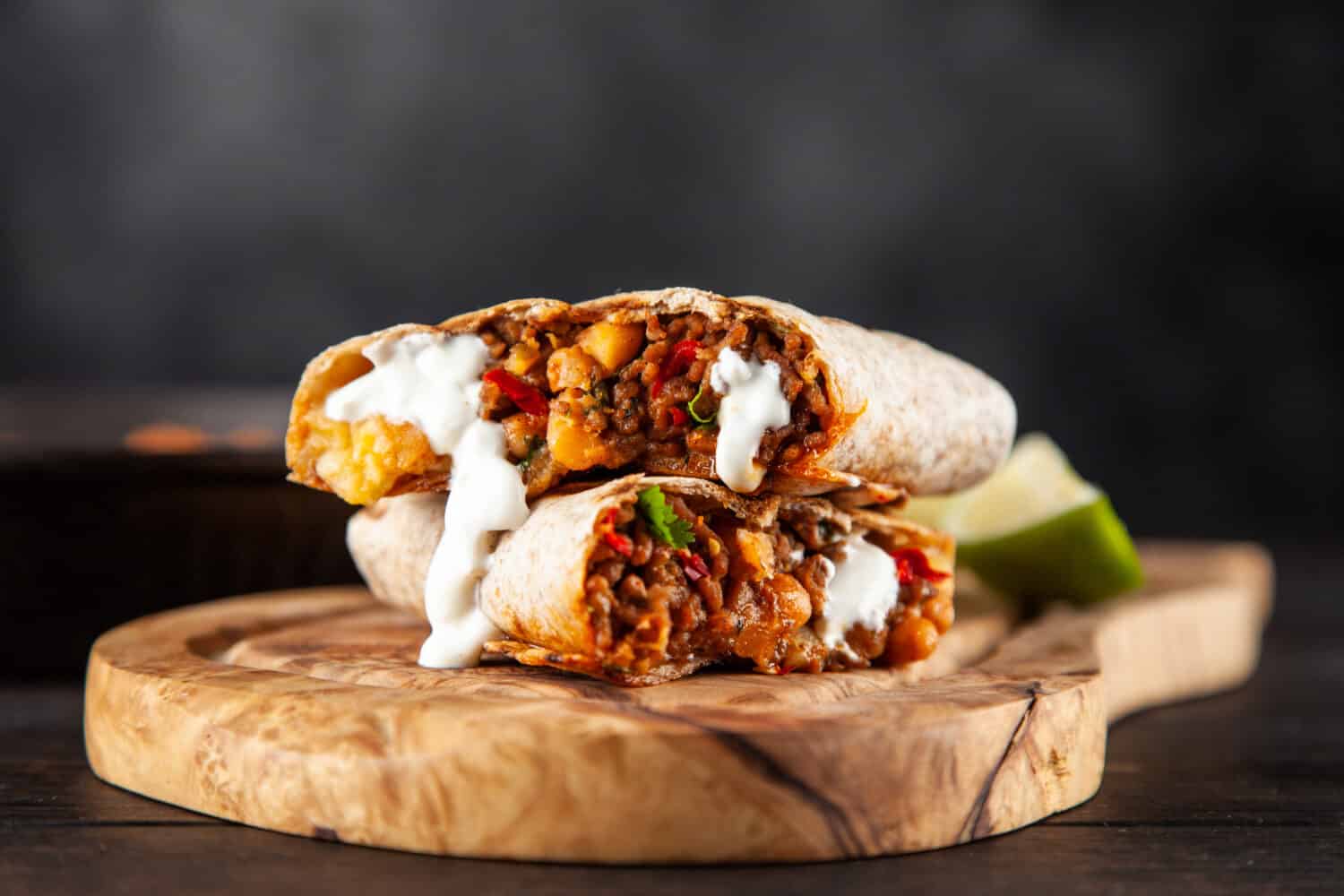
©George Dolgikh/Shutterstock.com
Substitution Options and Variations:
Apart from swapping wraps and burritos with one another, there are a lot of options in terms of personalizing and optimizing both dishes.
Lettuce Wraps
For a low-carb or gluten-free alternative, try using large lettuce leaves as a wrap substitute. Fill them with all your favorite wrap or burrito fillings and use your favorite dressing or dipping sauce to brighten the whole meal up. Pro-tip, use a variety like iceberg or romaine lettuce that has good pliability and isn't too prone to tearing. We personally also love butter lettuce as a wrap substitute, and it offers a better nutritional profile than some of the water-heavy varieties.
Dark, Leafy Green Wraps
Collard greens or green cabbage provide a sturdy and nutritious alternative to tortillas. Blanched or steamed collard green leaves make a delicious and sturdy wrap to encase flavorful fillings such as hummus, roasted vegetables, and quinoa. Because steaming the leaves helps them behave more like a tortilla, these are ideal, especially if you're trying to stuff or over-stuff them, like when making burritos.
Whole-Grain Tortillas
Choosing whole-grain tortillas for both wraps and burritos adds an extra nutritional boost because you're getting the parts of the wheat that your body actually needs. The higher fiber content keeps you feeling satisfied for longer and supports digestive health. And a whole-grain tortilla boasts a nuttier, more savory flavor profile, which is a great counter-flavor to the spice, heat, and bold flavors signature in the iconic burrito.
Best Burrito Recipes
Print
Veggie-filled Turkey Burrito
Ingredients
2 tablespoons canola oil
1 onion, halved, thinly sliced
1 pound lean ground turkey breast
Salt and pepper, to taste
3 cups shredded carrots
1 cup golden raisins
1 (15 ounce) can tomato sauce
1 teaspoon rubbed dried sage
1 teaspoon ground cinnamon
3 tablespoons finely chopped fresh parsley
1 (15 ounce) can lima beans, rinsed and drained
1½ cups crumbled queso blanco cheese
10 whole wheat flour tortillas
Instructions
1. Heat oil in a large pot over medium-high heat. Cook onion and ground turkey, stirring often, for 5 to 6 minutes or until turkey is browned and onion is softened. Season with salt and pepper.
2. Stir in shredded carrots and cook, stirring often, for 3 minutes.
3. Add raisins, tomato sauce, sage, cinnamon, parsley, and lima beans, stirring to combine. Cook for 2 minutes and then reduce heat to medium-low and simmer for 5 minutes, stirring occasionally.
4. Divide turkey mixture among tortillas and sprinkle with cheese. Fold tortilla ends over and roll burrito-style. Serve immediately.
Best Wrap Recipes
- Corn vs. Flour Tortillas
- Chicken Cutlets vs. Chicken Breast
- 29 Sandwich Wraps Perfect for Packing (Taste of Home)
Takeaways
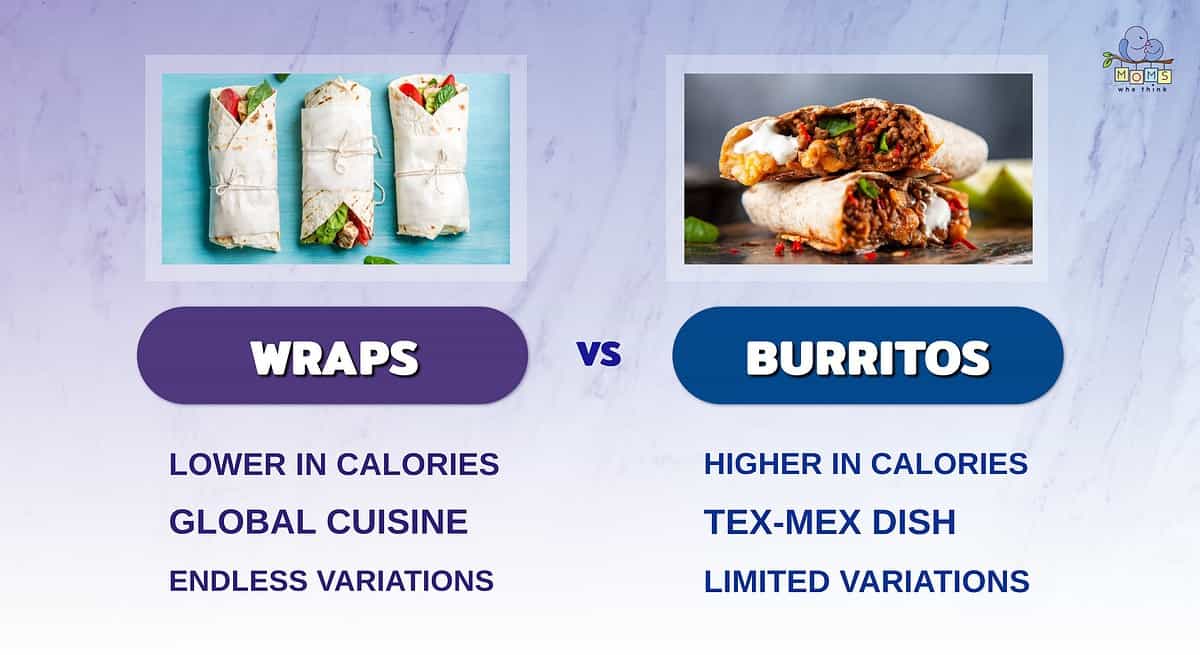
While both are typically made with tortillas, wraps, and burritos contrast in many ways. Let's take a look at how they differ:
- Burritos tend to be higher in calories due to the addition of cheese, sour cream, and other ingredients. Wraps, on the other hand, are associated with a healthier meal.
- While wraps are recognized worldwide (in different variations), burritos are more of a Mexican cuisine.
- There are countless ways to fill a wrap, depending on the meal. On the other hand, burritos consist of somewhat limited ingredients to stay true to its Tex-Mex roots.
Wraps and burritos may share a vibe, but they're both delicious and delightful. Wraps offer flexibility, portability, and a world of culinary possibilities, while burritos deliver bold flavors and hearty satisfaction. By understanding the nutritional differences and exploring substitution options, you can create a diverse range of meals that each suit the specific needs and preferences of the people at your table. Whether you're in the mood for a light and refreshing wrap or a robust and flavorful burrito, the only thing that limits you is your imagination! (And whatever you have in the pantry.)
